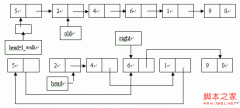C++模板元编程技术研究
摘要
本文描述了模板元编程技术的起源、概念和机制,并介绍了模板元编程技术在Blitz++和Loki程序库中的应用。
要害字
编译期计算 模板元编程 Blitz++ Loki
导言
1994年,C++标准委员会在圣迭哥举行的一次会议期间Erwin Unruh展示了一段可以产生质数的代码。这段代码的非凡之处在于质数产生于编译期而非运行期,在编译器产生的一系列错误信息中间夹杂着从2到某个设定值之间的所有质数:
// Prime number computation by Erwin Unruh
template
template
enum { prim = (p%i) && is_prime<(i > 2 ? p : 0), i -1> :: prim };
};
template < int i > struct Prime_print {
Prime_print
enum { prim = is_prime
void f() { D d = prim; }
};
struct is_prime<0,0> { enum {prim=1}; };
struct is_prime<0,1> { enum {prim=1}; };
struct Prime_print<2> { enum {prim = 1}; void f() { D<2> d = prim; } };
#ifndef LAST
#define LAST 10
#endif
main () {
Prime_print
}
类模板D只有一个参数为void*的构造器,而只有0才能被合法转换为void*。1994年,Erwin Unruh采用Metaware 编译器编译出错信息如下(以及其它一些信息,简短起见,它们被删除了):
Type `enum{}′ can′t be converted to tXPe `D<2>′ ("primes.cpp",L2/C25).
Type `enum{}′ can′t be converted to txpe `D<3>′ ("primes.cpp",L2/C25).
Type `enum{}′ can′t be converted to txpe `D<5>′ ("primes.cpp",L2/C25).
Type `enum{}′ can′t be converted to txpe `D<7>′ ("primes.cpp",L2/C25).
如今,上面的代码已经不再是合法的C++程序了。以下是Erwin Unruh亲手给出的修订版,可以在今天符合标准的C++编译器上进行编译:
// Prime number computation by Erwin Unruh
template
template
enum { prim = (p==2) (p%i) && is_prime<(i>2?p:0), i-1> :: prim };
};
template
Prime_print
enum { prim = is_prime
void f() { D d = prim ? 1 : 0; a.f();}
};
template<> struct is_prime<0,0> { enum {prim=1}; };
template<> struct is_prime<0,1> { enum {prim=1}; };
template<> struct Prime_print<1> {
enum {prim=0};
void f() { D<1> d = prim ? 1 : 0; };
};
#ifndef LAST
#define LAST 18
#endif
main() {
Prime_print
a.f();
}
在GNU C++ (MinGW Special) 3.2中编译这段程序时,编译器将会给出如下出错信息(以及其它一些信息,简短起见,它们被删除了):
Unruh.cpp:12: initializing argument 1 of `D::D(void*) [with int i = 17]'
Unruh.cpp:12: initializing argument 1 of `D::D(void*) [with int i = 13]'
Unruh.cpp:12: initializing argument 1 of `D::D(void*) [with int i = 11]'
Unruh.cpp:12: initializing argument 1 of `D::D(void*) [with int i = 7]'
Unruh.cpp:12: initializing argument 1 of `D::D(void*) [with int i = 5]'
Unruh.cpp:12: initializing argument 1 of `D::D(void*) [with int i = 3]'
Unruh.cpp:12: initializing argument 1 of `D::D(void*) [with int i = 2]'
这个例子展示了可以利用模板实例化机制于编译期执行一些计算。这种通过模板实例化而执行的非凡的编译期计算技术即被称为模板元编程。
顺便说一句,因为编译器的出错信息并未被标准化,所以,假如你在Visual C++、Borland C++等编译器上看不到这么具体的出错信息,请不必讶异。
一个可以运行的模板元编程例子
模板元编程(Template Metaprogramming)更准确的含义应该是“编‘可以编程序的’程序”,而模板元程序(Template Metaprogram)则是“‘可以编程序的’程序”。也就是说,我们给出代码的产生规则,编译器在编译期解释这些规则并生成新代码来实现我们预期的功能。
Erwin Unruh的那段经典代码并没有执行,它只是以编译出错信息的方式输出中间计算结果。让我们来看一个可以运行的模板元编程例子 ― 计算给定整数的指定次方:
// xy.h
//原始摸板
template
class XY
{
public:
enum { result_ = Base * XY
};
//用于终结递归的局部特化版
template
class XY
{
public:
enum { result_ = 1 };
};
模板元编程技术之根本在于递归模板实例化。第一个模板实现了一般情况下的递归规则。当用一对整数
让我们看看使用此模板来计算5^4 (通过实例化XY<5, 4>)时发生了什么:
// xytest.cpp
#include
#include "xy.h"
int main()
{
std::cout << "X^Y<5, 4>::result_ = " << XY<5, 4>::result_;
}
首先,编译器实例化XY<5, 4>,它的result_为5 * XY<5, 3>::result_,如此一来,又需要针对<5, 3>实例化同样的模板,后者又实例化XY<5, 2>…… 当实例化到XY<5, 0>的时候,result_的值被计算为1,至此递归结束。
递归模板实例化的深度和终结条件
可以想象,假如我们以非常大的Y值来实例化类模板XY,那肯定会占用大量的编译器资源甚至会迅速耗尽可用资源(在计算结果溢出之前),因此,在实践中我们应该有节制地使用模板元编程技术。
虽然 C++标准建议的最小实例化深度只有17层,然而大多数编译器都能够处理至少几十层,有些编译器答应实例化至数百层,更有一些可达数千层,直至资源耗尽。
假如我们拿掉XY模板局部特化版本,情况会如何?
// xy2.h
//原始摸板
template
class XY
{
public:
enum { result_ = Base * XY
};
测试程序不变:
// xytest2.cpp
#include
#include "xy2.h"
int main()
{
std::cout << "X^Y<5, 4>::result_ = " << XY<5, 4>::result_;
}
执行如下编译命令:
C:>g++ -c xytest2.cpp
你将会看到递归实例化将一直进行下去,直到达到编译器的极限。
GNU C++ (MinGW Special) 3.2的默认实例化极限深度为500层,你也可以手工调整实例化深度:
C:>g++ -ftemplate-depth-3400 -c xytest2.cpp
事实上,就本例而言,g++ 3.2答应的实例化极限深度还可以再大一些(我的测试结果是不超过3450层)。
因此,在使用模板元编程技术时,我们总是要给出原始模板的特化版(局部特化版或完全特化版或兼而有之),以作为递归模板实例化的终结准则。
利用模板元编程技术解开循环
模板元编程技术最早的实际应用之一是用于数值计算中的解循环。举个例子,对一个数组进行求和的常见方法是:
// sumarray.h
template
inline T sum_array(int Dim, T* a)
{
T result = T();
for (int i = 0; i < Dim; ++i)
{
result += a[i];
}
return result;
}
这当然可行,但我们也可以利用模板元编程技术来解开循环:
// sumarray2.h
// 原始模板
template
class Sumarray
{
public:
static T result(T* a)
{
return a[0] + Sumarray
}
};
// 作为终结准则的局部特化版
template
class Sumarray<1, T>
{
public:
static T result(T* a)
{
return a[0];
}
};
用法如下:
// sumarraytest2.cpp
#include
#include "sumarray2.h"
int main()
{
int a[6] = {1, 2, 3, 4, 5, 6};
std::cout << " Sumarray<6>(a) = " << Sumarray<6, int>::result(a);
}
当我们计算Sumarray<6, int>::result(a)时,实例化过程如下:
Sumarray<6, int>::result(a)
= a[0] + Sumvector<5, int>::result(a+1)
= a[0] + a[1] + Sumvector<4, int>::result(a+2)
= a[0] + a[1] + a[2] + Sumvector<3, int>::result(a+3)
= a[0] + a[1] + a[2] + a[3] + Sumvector<2, int>::result(a+4)
= a[0] + a[1] + a[2] + a[3] + a[4] + Sumvector<1, int>::result(a+5)
= a[0] + a[1] + a[2] + a[3] + a[4] + a[5]
可见,循环被展开为a[0] + a[1] + a[2] + a[3] + a[4] + a[5]。这种直截了当的展开运算几乎总是比循环来得更有效率。
也许拿一个有着600万个元素的数组来例证循环开解的优势可能更有说服力。生成这样的数组很轻易,有爱好,你不妨测试、对比一下。
(感谢一位不知名的朋友的测试。他说:“据在Visual C++ 2003上实测编译器应当进行了尾递归优化,可以不受上面说的递归层次的限制,然而连加的结果在数组个数达到4796之后就不再正确了,程序输出了空行,已经出错” ― 2003年12月30日补充)
模板元编程在数值计算程序库中的应用
Blitz++之所以“快如闪电”(这正是blitz的字面含义),离不开模板元程序的功劳。Blitz++淋漓尽致地使用了元编程技术,你可以到这些文件源代码中窥探究竟:
dot.h
matassign.h
matmat.h
matvec.h
metaprog.h
product.h
sum.h
vecassign.h
让我们看看Blitz++程序库dot.h文件中的模板元程序:
template
class _bz_meta_vectorDot {
public:
enum { loopFlag = (I < N-1) ? 1 : 0 };
template
static inline BZ_PROMOTE(_bz_typename T_expr1::T_numtype, _bz_typename T_expr2::T_numtype)
f(const T_expr1& a, const T_expr2& b)
{
return a[I] * b[I] + _bz_meta_vectorDot
}
template
static inline BZ_PROMOTE(_bz_typename T_expr1::T_numtype, _bz_typename T_expr2::T_numtype)
f_value_ref(T_expr1 a, const T_expr2& b)
{
return a[I] * b[I] + _bz_meta_vectorDot
}
template
static inline BZ_PROMOTE(_bz_typename T_expr1::T_numtype, _bz_typename T_expr2::T_numtype)
f_ref_value(const T_expr1& a, T_expr2 b)
{
return a[I] * b[I] + _bz_meta_vectorDot
}
template
static inline BZ_PROMOTE(_bz_typename T_expr1::T_numtype, P_numtype2)
dotWithArgs(const T_expr1& a, P_numtype2 i1, P_numtype2 i2=0,
P_numtype2 i3=0, P_numtype2 i4=0, P_numtype2 i5=0, P_numtype2 i6=0,
P_numtype2 i7=0, P_numtype2 i8=0, P_numtype2 i9=0, P_numtype2 i10=0)
{
return a[I] * i1 + _bz_meta_vectorDot
(a, i2, i3, i4, i5, i6, i7, i8, i9);
}
};
template<>
class _bz_meta_vectorDot<0,0> {
public:
template
static inline _bz_meta_nullOperand f(const T_expr1&, const T_expr2&)
{ return _bz_meta_nullOperand(); }
template
static inline _bz_meta_nullOperand
dotWithArgs(const T_expr1& a, P_numtype2 i1, P_numtype2 i2=0,
P_numtype2 i3=0, P_numtype2 i4=0, P_numtype2 i5=0, P_numtype2 i6=0,
P_numtype2 i7=0, P_numtype2 i8=0, P_numtype2 i9=0, P_numtype2 i10=0)
{
return _bz_meta_nullOperand();
}
};
这段代码远比它乍看上去的简单。_bz_meta_vectorDot类模板使用了一个临时变量loopFlag来存放每一步循环条件的评估结果,并使用了一个完全特化版作为递归终结的条件。需要说明的是,和几乎所有元程序一样,这个临时变量作用发挥于编译期,并将从运行代码中优化掉。
Todd是在Blitz++数值数组库的主要作者。这个程序库(以及MTL和POOMA等程序库)例证了模板元程序可以为我们带来更加高效的数值计算性能。Todd宣称Blitz++的性能可以和对应的Fortran程序库媲美。
Loki程序库:活用模板元编程技术的典范
模板元编程的价值仅仅在于高性能数值计算吗?不仅如此。Loki程序库以对泛型模式的开创性工作闻名于C++社群。它很巧妙地利用了模板元编程技术实现了Typelist组件。Typelist是实现Abstract Factory、Visitor等泛型模式不可或缺的基础设施。
就像C++标准库组件std::list提供对一组数值的操作一样,Typelist可以用来操纵一组类型,其定义非常简单(摘自Loki程序库Typelist.h单元):
template
struct Typelist
{
typedef T Head;
typedef U Tail;
};
显然,Typelist没有任何状态,也未定义任何操作,其作用只在于携带类型信息,它并未打算被实例化,因此,对于Typelist的任何处理都必然发生于编译期而非运行期。
Typelist可以被无限扩展,因为模板参数可以是任何类型(包括该模板的其他具现体)。例如:
Typelist
就是一个包含有char、int、float三种类型的Typelist。
按照Loki的约定,每一个Typelist都必须以NullType结尾。NullType的作用类似于传统C字符串的“\0”,它被声明于Loki程序库的NullType.h文件中:
class NullType;
NullType只有声明,没有定义,因为Loki程序库永远都不需要创建一个NullType对象。
让我们看看IndexOf模板元程序,它可以在一个Typelist中查找给定类型的位置(摘自Loki程序库的Typelist.h单元):
template
struct IndexOf;
template
struct IndexOf
{
enum { value = -1 };
};
template
struct IndexOf
{
enum { value = 0 };
};
template
struct IndexOf
{
private:
enum { temp = IndexOf
public:
enum { value = (temp == -1 ? -1 : 1 + temp) };
};
IndexOf提供了一个原始模板和三个局部特化版。算法非常简单:假如TList(就是一个Typelist)是一个NullType,则value为-1。假如TList的头部就是T,则value为0。否则将IndexOf施行于TList的尾部和T,并将评估结果置于一个临时变量temp中。假如temp为-1,则value为-1,否则value为1 + temp。
为了加深你对Typelist采用的模板元编程技术的熟悉,我从Loki程序库剥离出如下代码,放入一个typelistlite.h文件中:
// typelistlite.h
// 声明Nulltype
class NullType;
// Typelist的定义
template
struct Typelist
{
typedef T Head;
typedef U Tail;
};
// IndexOf的定义
// IndexOf原始模板
template
// 针对NullType的局部特化版
template
struct IndexOf
{
enum { value = -1 };
};
// 针对“Tlist头部就是我们要查找的T”的局部特化版
template
struct IndexOf
{
enum { value = 0 };
};
// 处理Tlist尾部的局部特化版
template
struct IndexOf
{
private:
enum { temp = IndexOf
public:
enum { value = (temp == -1 ? -1 : 1 + temp) };
};
测试程序如下:
// typelistlite_test.cpp
#include
#include "typelistlite.h"
// 自定义类型Royal
class Royal {};
// 定义一个包含有char、int、Royal和float的Typelist
typedef Typelist
int main()
{
std::cout << "IndexOf
";
std::cout << "IndexOf
";
std::cout << "IndexOf
";
}
程序输出如下:
IndexOf
IndexOf
IndexOf
结束语
模板元编程技术并非都是优点,比方说,模板元程序编译耗时,带有模板元程序的程序生成的代码尺寸要比普通程序的大,而且通常这种程序调试起来也比常规程序困难得多。另外,对于一些程序员来说,以类模板的方式描述算法也许有点抽象。
编译耗时的代价换来的是卓越的运行期性能。通常来说,一个有意义的程序的运行次数(或服役时间)总是远远超过编译次数(或编译时间)。为程序的用户带来更好的体验,或者为性能要求严格的数值计算换取更高的性能,值得程序员付出这样的代价。
很难想象模板元编程技术会成为每一个普通程序员的日常工具,相反,就像Blitz++和Loki那样,模板元程序几乎总是应该被封装在一个程序库的内部。对于库的用户来说,它应该是透明的。模板元程序可以(也应该)用作常规模板代码的内核,为要害的算法实现更好的性能,或者为非凡的目的实现非凡的效果。
模板元编程技术首次正式亮相于Todd Veldhuizen的Using C++ Template Metaprograms论文之中。这篇文章首先发表于1995年5月的C++ Report期刊上,后来Stanley Lippman编辑C++ Gems一书时又收录了它。参考文献中给出了这篇文章的链接,它还描述了许多本文没有描述到的内容。
- 上一篇:揭开NTFS下流的奥秘
- 下一篇:利用操作系统提供的API编写防火墙





